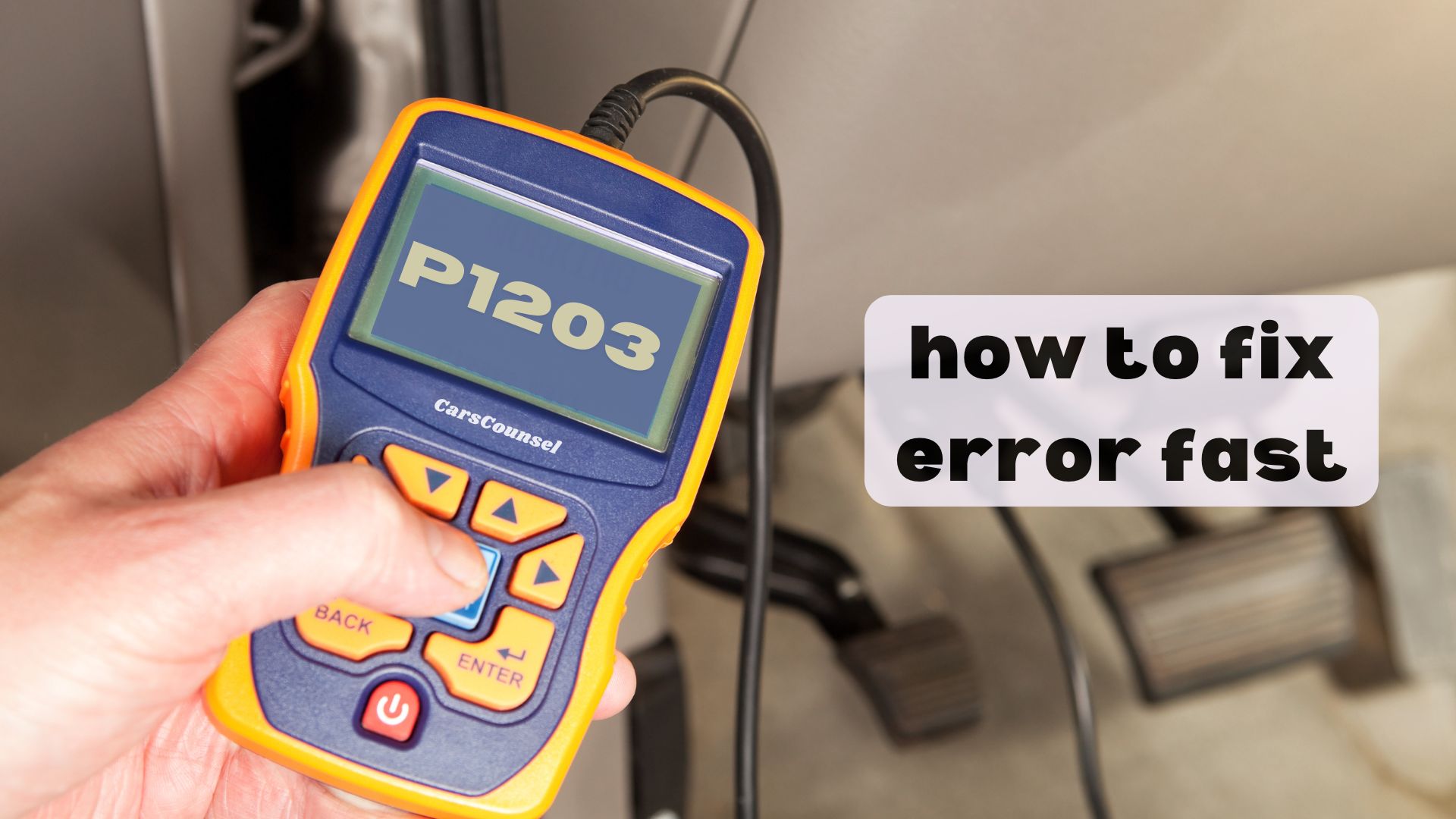As you turn the key in the ignition, your engine sputters to life, but something’s off – it’s struggling to find its rhythm, like a musician playing a discordant note. The check engine light flickers on, and your dashboard display reveals the cryptic code P1203. This code signals a fuel system failure, causing a misfire in the No. 3 cylinder, and you’re left wondering what’s behind this problem and how to fix it.

Quick Navigation
Key Takeaways
- The P1203 code indicates a fuel system failure causing a misfire in the No. 3 cylinder, disrupting the Fuel System Overview.
- Symptoms include rough idling, decreased power, decreased fuel efficiency, illuminated Check Engine Light, and unusual engine sounds.
- Common causes include faulty fuel injectors, malfunctioning fuel pumps, clogged fuel filters, and fuel pressure regulator issues.
- Diagnosis involves retrieving the trouble code, fuel injector testing, fuel pressure monitoring, and inspecting fuel system components.
- Repairs involve replacing faulty components, clearing the trouble code, and implementing preventative measures like regular fuel filter replacements and inspections.
Understanding Code P1203
When your vehicle’s onboard computer stores a P1203 code, it’s indicating a fuel system failure that’s causing a misfire in the No. 3 cylinder of the engine.
This failure disrupts the Fuel System Overview, which relies on precise fuel delivery to each cylinder. As a result, Engine Performance suffers, leading to decreased power and efficiency.
The misfire occurs when the fuel mixture in the combustion chamber fails to ignite at the correct time, causing a loss of power and rough idling.
Understanding this error code is vital to identifying the root cause of the problem and making necessary repairs.
Symptoms of a Misfire in the No. 3 Cylinder
One common symptom of a misfire in the No. 3 cylinder is rough idling or vibrations that can be felt throughout the vehicle.
As you’re driving, you may notice a decrease in power and acceleration, making it harder to climb hills or merge onto highways.
- Decreased fuel efficiency: A misfire in the No. 3 cylinder can lead to poor engine performance, resulting in lower gas mileage.
- Illuminated Check Engine Light: If your vehicle’s onboard computer detects a misfire, it will trigger the Check Engine Light to come on.
- Unusual engine sounds: Fuel injector issues or ignition timing problems can cause unusual sounds, such as knocking, pinging, or popping noises, coming from the engine.
Common Causes of P1203 Code
As you investigate the P1203 code, it’s likely you’re wondering what’s causing the misfire in your No. 3 cylinder.
A faulty fuel injector may be the culprit, preventing proper fuel delivery due to poor fuel injector cleanliness.
Faulty fuel injectors can prevent proper fuel delivery due to poor cleanliness, leading to misfires and reduced engine performance.
Alternatively, a malfunctioning fuel pump could be reducing fuel pressure, affecting fuel pump efficiency.
Other possible causes include a clogged fuel filter, fuel pressure regulator issues, or other problems within the fuel system.
Identifying the root cause is vital to resolving the misfire and restoring your engine’s performance.
Diagnosing the Fuel System Failure
You’ll need to take a systematic approach to diagnose the fuel system failure causing the P1203 code.
Start by retrieving the trouble code using a scan tool to understand the specific issue.
Then, perform fuel injector testing to identify if a faulty injector is the culprit.
Additionally, conduct fuel pressure monitoring to check if the pressure is within the recommended specifications.
- Check the fuel pressure gauge to verify it’s within the recommended range.
- Use a fuel injector tester to diagnose any issues with the No. 3 cylinder fuel injector.
- Monitor the fuel system’s performance using a scan tool to identify any other issues.
Inspecting Fuel System Components
Inspecting fuel system components is a crucial step in diagnosing the root cause of the P1203 code.
You’ll need to perform a thorough inspection to identify any faulty or damaged components. Start by conducting fuel injector testing to check for any blockages or leaks.
Next, perform fuel pressure checks to verify the system is operating within the recommended pressure range.
Additionally, inspect the fuel filter, fuel pump, and fuel pressure regulator for signs of malfunction or wear.
Replacing Faulty Fuel System Components
Once you’ve identified the faulty fuel system component responsible for the P1203 code, it’s time to replace it.
You’ve narrowed down the issue, now it’s time to take action. Replacing the faulty component will guarantee proper fuel flow and pressure, resolving the misfire in the No. 3 cylinder.
- Fuel injector cleaning or replacement: Verify the new fuel injector is compatible with your vehicle’s make and model.
- Fuel pump testing and replacement: If the pump is faulty, replace it with a high-quality OEM or aftermarket part.
- Other component replacements: Don’t forget to inspect and replace other faulty components, such as the fuel filter or fuel pressure regulator, to prevent future issues.
Clearing the Trouble Code
After replacing the faulty fuel system component, the next step is to clear the trouble code from your vehicle’s onboard computer.
This process, known as code erasure, will reset the Check Engine Light on your dashboard. You’ll need a scan tool to connect to your vehicle’s onboard computer and delete the P1203 code.
Reset the Check Engine Light on your dashboard by connecting a scan tool to your vehicle’s onboard computer and deleting the P1203 code.
Follow the manufacturer’s instructions to guarantee a successful code erasure. Once complete, the dashboard warning lights should turn off, and your vehicle’s computer will no longer store the trouble code.
This will confirm that the issue has been resolved, and your vehicle is running smoothly again.
Typical Repair Costs and Time
The repair costs for fixing the P1203 code can vary widely, depending on the specific cause of the fuel system failure and misfire in the No. 3 cylinder.
You can expect to pay anywhere from $200 to $800, depending on the complexity of the repair.
- Fuel system overhaul: If multiple components need to be replaced, the cost can add up quickly.
- Replacing a faulty fuel injector or fuel pump can be relatively expensive.
- Repair shop reviews: Be sure to research and choose a reputable mechanic to guarantee you get a fair price for the repair, and to certify that the work is done correctly.
Preventing Future Fuel System Failures
To avoid future fuel system failures, you’ll want to stay on top of regular maintenance and inspections.
By doing so, you’ll be able to identify potential issues before they become major problems. Implement fuel efficiency tips like maintaining the correct tire pressure, removing extra weight, and using the correct oil type to reduce fuel consumption.
As preventative measures, regularly replace fuel filters, inspect fuel injectors, and check fuel pressure regulators. These simple steps will help you avoid costly repairs and guarantee your vehicle runs smoothly and efficiently, thereby certifying a long-lasting performance.
Importance of Regular Vehicle Maintenance
Regular tune-ups and inspections are pivotal for detecting potential issues before they escalate into costly repairs, and you play a paramount role in ensuring your vehicle’s longevity.
By staying on top of routine maintenance, you can prevent problems like fuel system failures and misfires.
Remember to:
- Get regular oil changes to keep your engine lubricated and running smoothly.
- Rotate your tires every 5,000 to 8,000 miles to maintain even tread wear and prevent uneven wear patterns.
- Check your vehicle’s fluids regularly, including coolant, transmission, and brake fluid, to catch any potential leaks or issues early on.
More OBD-II Codes
| P1198 | P1146 | P1145 | P1144 |
| P1143 | P1142 | P1140 | P1139 |
| P1141 | P1138 | P1137 | P1222 |
| P1221 | P1214 | P1213 | P1212 |
| P1173 | P1325 | P1245 | P1244 |
| P1243 | P1225 | P1224 | P1223 |
Frequently Asked Questions
Can I Continue Driving With a P1203 Code?
You’re wondering if it’s safe to keep driving with a P1203 code. While it’s possible, you’re risking further engine damage, decreased fuel efficiency, and poor performance, which can lead to more costly repairs down the road.
Will a P1203 Code Cause Permanent Engine Damage?
If you ignore a fuel pump failure, it’s like playing Russian roulette with your engine – you’re risking catastrophic damage! Continuing to drive can lead to severe engine performance issues, potentially causing irreversible harm, so address the problem ASAP to avoid costly repairs.
Can I Clear the Code Myself Without Fixing the Issue?
You can clear the code yourself, but be aware that it won’t fix the underlying issue, and the code will likely return, causing further consequences. DIY limitations apply, as ignoring the problem can lead to more severe engine damage.
Will a Fuel Injector Cleaner Fix the P1203 Code?
“A bird in the hand is worth two in the bush,” but in this case, a fuel injector cleaner might not be the solution you’re holding onto. You’ll need to address the root cause, as a cleaner won’t fix faulty injector flow or low fuel pressure, which may be causing the misfire.
Can a Faulty Oxygen Sensor Cause a P1203 Code?
You’re wondering if a faulty oxygen sensor can cause a P1203 code. The answer is no, as a faulty oxygen sensor typically affects sensor response, which doesn’t directly impact fuel efficiency or cause a misfire in the No. 3 cylinder.
Conclusion
You’ve addressed the P1203 code and got your engine running smoothly again, but don’t think you’re off the hook that easily. You might be thinking, “I’ll just wait until another issue arises before bringing my vehicle in again.” However, neglecting regular maintenance will only lead to more costly repairs down the line. Stay on top of your vehicle’s needs, and it’ll reward you with peak performance and fuel efficiency.

